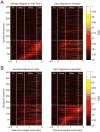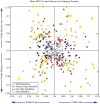Representation of multiple, independent categories in the primate prefrontal cortex
- PMID: 20547135
- PMCID: PMC2909642
- DOI: 10.1016/j.neuron.2010.05.005
Representation of multiple, independent categories in the primate prefrontal cortex
Abstract
Neural correlates of visual categories have been previously identified in the prefrontal cortex (PFC). However, whether individual neurons can represent multiple categories is unknown. Varying degrees of generalization versus specialization of neurons in the PFC have been theorized. We recorded from lateral PFC neural activity while monkeys switched between two different and independent categorical distinctions (Cats versus Dogs, Sports Cars versus Sedans). We found that many PFC neurons reflected both categorical distinctions. In fact, these multitasking neurons had the strongest category effects. This stands in contrast to our lab's recent report that monkeys switching between competing categorical distinctions (applied to the same stimulus set) showed independent representations. We suggest that cognitive demands determine whether PFC neurons function as category "multitaskers."
Copyright 2010 Elsevier Inc. All rights reserved.
Figures







References
-
- Beymer D, Poggio T. Image representations for visual learning. Science. 1996;272:1905–1909. - PubMed
-
- Bolte S, Holtmann M, Poustka F, Scheurich A, Schmidt L. Gestalt perception and local-global processing in high-functioning autism. J Autism Dev Disord. 2007;37:1493–1504. - PubMed
-
- Buschman TJ, Miller EK. Rules through recursion: How interactions between the frontal cortex and basal ganglia may build abstract, complex, rules from concrete, simple, ones. In: Bunge SA, Wallis JD, editors. Neuroscience of rule-guided behavior. Oxford; New York: Oxford University Press; 2008.
Publication types
MeSH terms
Grants and funding
LinkOut - more resources
Full Text Sources
Other Literature Sources
Miscellaneous

